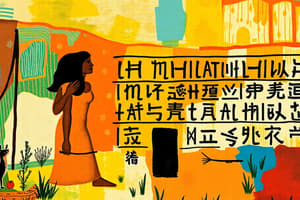Podcast
Questions and Answers
What agricultural technique involves an artificial supply of water to land?
What agricultural technique involves an artificial supply of water to land?
- Farming
- Plowing
- Irrigation (correct)
- Fertility
A Ziggurat was a type of building used primarily for residential purposes in Mesopotamia.
A Ziggurat was a type of building used primarily for residential purposes in Mesopotamia.
False (B)
Who was the most powerful king of Babylon known for writing the first law code?
Who was the most powerful king of Babylon known for writing the first law code?
Hammurabi
The belief in many gods is referred to as __________.
The belief in many gods is referred to as __________.
Match the following concepts with their definitions:
Match the following concepts with their definitions:
Which of the following rivers was NOT one of the two major rivers in Mesopotamia?
Which of the following rivers was NOT one of the two major rivers in Mesopotamia?
The population of Babylon reached approximately 200,000 people.
The population of Babylon reached approximately 200,000 people.
What was the primary benefit of irrigation in Mesopotamia?
What was the primary benefit of irrigation in Mesopotamia?
Historians believe that farming developed in __________.
Historians believe that farming developed in __________.
Which of the following was NOT an invention that increased agricultural production?
Which of the following was NOT an invention that increased agricultural production?
Flashcards
Silt
Silt
Rich, fertile soil that is ideal for growing crops.
Irrigation
Irrigation
A system of supplying water to farmland, usually through artificial channels.
City-State
City-State
A large city that functions as an independent state with its own government, laws, and rulers.
Polytheistic
Polytheistic
Signup and view all the flashcards
Ziggurat
Ziggurat
Signup and view all the flashcards
Cuneiform
Cuneiform
Signup and view all the flashcards
Empire
Empire
Signup and view all the flashcards
Surplus
Surplus
Signup and view all the flashcards
Law
Law
Signup and view all the flashcards
Writing
Writing
Signup and view all the flashcards
Study Notes
Mesopotamia: Agriculture and Early Civilizations
-
Fertile Land & Irrigation: Mesopotamia's fertile soil and access to the Tigris and Euphrates Rivers supported agriculture. Irrigation, the artificial water supply, facilitated increased food production. More food led to a larger population and settlement in the area.
-
Inventions for Increased Agricultural Production: Canals, plows, and the wheel were key inventions that revolutionized farming practices in Mesopotamia.
-
Urban Development (e.g., Babylon): A successful city requires a significant population, recognized individuals, and impressive architecture. Babylon, located on the Euphrates River, was a prominent city-state demonstrating these characteristics.
Writing and Law Systems
-
Cuneiform: Cuneiform, an early writing system, evolved from using tokens to track goods to the more efficient system of using clay tablets and cuneiform script.
-
Organization and Complexity: More complex cities necessitated better systems for tracking goods and maintaining order, which ultimately led to the development of writing.
-
Hammurabi's Code: King Hammurabi of Babylon ruled for 42 years and created a set of laws known as Hammurabi's Code. This code is notable for its harsh punishments.
Characteristics of Civilizations
-
Urban Areas: A successful civilization typically develops an urban area with diverse jobs and a coordinated workforce, where everyone contributes to the community's well-being. An example is Babylon.
-
Population Growth: Increased food surplus from agricultural advancements led to greater population density and settlement growth in Mesopotamia.
-
Organized Government and Laws: A large population requires an organized structure for administration and maintaining social order. These structures are often developed from the need to manage a large community.
-
City-States: A city-state is a large city that controls a surrounding area and has its own government and laws.
Studying That Suits You
Use AI to generate personalized quizzes and flashcards to suit your learning preferences.




